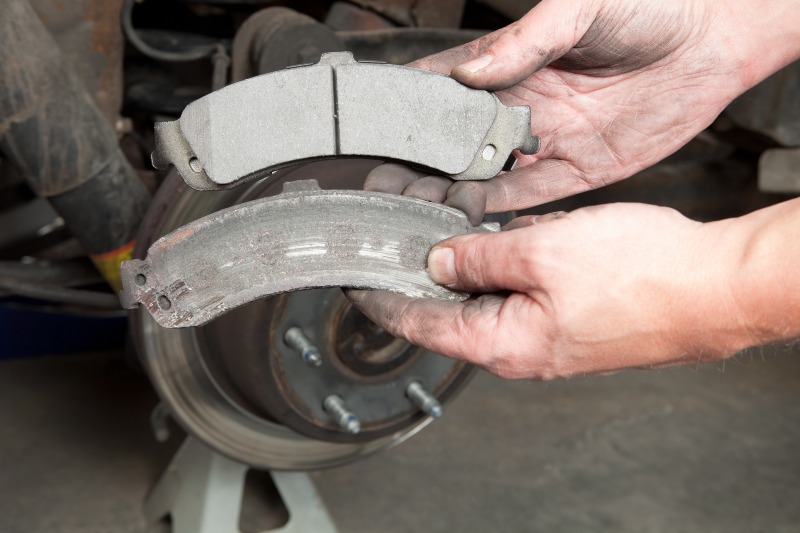How to Check Your Brake Pads
Your car’s brake pads play a vital role in keeping you safe on the road. Over time, they wear down and need replacing to ensure your vehicle stops smoothly and effectively. But how do you know when it’s time to replace them? Let’s walk through everything you need to know about brake pads, how to check them, and how to extend their lifespan.

What Are Brake Pads?
Brake pads are an important part of your car’s braking system. They are flat, rectangular pieces made of friction material that press against the brake rotors when you step on the brake pedal.
Brake pads are designed to absorb and dissipate heat while creating the friction needed to slow your car. Without functional brake pads, stopping your vehicle becomes difficult and dangerous.
What Do Brake Pads Do?
Brake pads create the friction needed to bring your car to a stop. When you press the brake pedal, hydraulic fluid forces the calipers to squeeze the brake pads against the rotors. This friction converts kinetic energy into heat, effectively slowing down the wheels. Because they endure intense heat and pressure, brake pads wear down over time. Regular checks and timely brake pad replacement are critical to maintaining your car’s safety and performance.
How Can I Tell If My Brakes Need Replacing?
Brake pads typically last between 25,000 and 70,000 miles, depending on your driving habits and the type of pads your vehicle uses. However, they don’t last forever. Look out for these signs that your brake pads may need replacing:
- Squealing or screeching noises: A high-pitched sound when braking often indicates worn brake pads.
- Grinding noises: This could mean your brake pads are completely worn down, causing metal-on-metal contact.
- Reduced braking performance: If your car takes longer to stop, it’s time to inspect your pads.
- Vibration in the brake pedal: This might indicate uneven pad wear.
How Do I Check My Brake Pads?
You can check your brake pads in a few ways, depending on your tools and comfort level.
Check Brake Pads Without Removing the Wheel
- Look through the wheel spokes: Many vehicles have enough space between the wheel spokes to see the brake pads.
- Inspect the thickness: Brake pads should generally be at least 1/4 inch thick. If they appear thinner, it’s time to replace them.
- Check for wear indicators: Some brake pads have a metal tab that makes noise when the pad wears thin.
Recognize the Symptoms of Worn Brake Pads
- Listen for squealing or grinding.
- Check your dashboard for a brake warning light, which might indicate low pad thickness.
Check Brake Pads by Removing the Wheel
- Gather tools: You’ll need a jack, lug wrench, and flashlight.
- Remove the wheel: After securely lifting the car with a jack, remove the wheel to expose the brake pads.
- Measure the pads: Use a ruler or gauge to measure the thickness. If they’re less than 1/4 inch, consider replacement.
- Inspect the rotors: Look for grooves or damage, which could mean your pads are overdue for replacement.
How to Make Brake Pads Last Longer
Extending the life of your brake pads not only saves you money but also ensures your vehicle stays safe on the road. One of the best ways to preserve your brake pads is to drive smoothly, avoiding hard braking whenever possible and opting for gradual stops, which reduce wear. Carrying heavy loads can also put extra stress on your brakes, so it’s a good idea to minimize excess weight in your vehicle. When driving downhill, use engine braking by downshifting to take some of the strain off your brakes. Lastly, don’t overlook the importance of routine maintenance. Regular brake inspections can identify and address potential issues early, helping your brake pads last longer.
Conclusion
Checking your brake pads regularly helps ensure your safety and the longevity of your car. Whether you inspect them yourself or rely on professionals, knowing the signs of brake pad wear can save you trouble down the road.
Why Choose Maryland Muffler?
At Maryland Muffler in Millersville, Maryland, we specialize in brake pad replacement and comprehensive brake system inspections. Our experienced technicians ensure your brakes are in top shape, using only high-quality parts to keep you safe. When it comes to how long brake pads last or learning how to check brake pads, we’re here to help with expert advice and reliable service. Contact us today.
